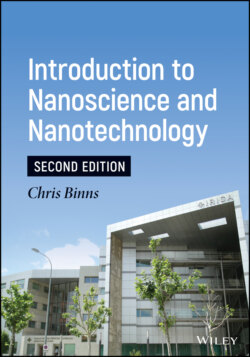Читать книгу Introduction to Nanoscience and Nanotechnology - Chris Binns - Страница 11
Introduction to Second Edition
ОглавлениеIt has been 11 years since the first edition of this book was published, and in such a rapidly evolving field it is important to provide an updated report of the current state of affairs. Of course, the basic science has not changed, but in the last 11 years there has been a number of noteworthy developments in the basic tools and materials of nanotechnology and further penetration into commercially available materials and devices. An example is the entirely new branch of nanotechnology that has developed around graphene, which is a single atomic layer of carbon. This material was mentioned in passing in the first edition, but in the intervening 11 years has become a major research field. In this edition, as well as providing an update for the previous work, there are additional chapters describing developments in the research on graphene, nanobubbles, nanofluidics, and nanoscale interfaces. These are all topics that provide additional linkages between the various scientific disciplines that merge to form nanoscience.
World‐wide funding of research in nanotechnology continues to grow. The figure quoted in the first edition for government funding alone was four billion dollars, but the latest available forecast [1] predicts a global nanotechnology market of 125 billion dollars by 2024, a compound annual growth of 28% over the 14 years. As the nanotechnology industry has grown, it has become more appropriate to count the total market as opposed to just government spending, which dominated the figures back in 2010. It is interesting to note that the first edition predicted an annual growth of 20%, which is proving to be an underestimate.
It is clear that nanotechnology is expected to have a significant impact on our lives, so what is it and what does it do? These simple direct questions, unfortunately, do not have simple direct answers, and it very much depends on who you ask. There are thousands of researchers in nanotechnology in the world and one suspects that one would get thousands of different responses. A definition that would probably offend the smallest number of researchers is that, nanotechnology is the study and the manipulation of matter at length scales of the order of a few nanometers (100 atoms or so) to produce useful materials and devices.
This still leaves a lot of room for maneuver. A nanotechnologist working in the cosmetics industry might tell you that it is achieving better control of tiny particles, a few nanometers across (nanoparticles) so that sunscreens or cosmetic creams achieve a smoother distribution over the skin. A scientist working at the so‐called “life sciences interface” might say that it is finding ways of targeting magnetic nanoparticles to tumors in the body in the development of revolutionary cancer treatments. A researcher working on graphene‐based molecular electronics would tell you that it is creating electronic circuits in which the active components are a thousand times smaller than a single transistor on a Pentium IV chip. Some nanotechnologists (a small minority) would also suggest you that it is finding ways to build tiny robots whose components are the size of molecules (nanobots).
We will talk in detail about size scales in Chapter 1, but for the moment consider Figure I.1, which shows, schematically, the size scale of interest in nanotechnology (The Nanoworld) with sizes plotted on a logarithmic scale. For reasons that will become clear in Chapter 1, the upper edge of the Nanoworld is set at about 100 nm. Even though this is hundreds of times smaller than the tiniest mote you can see with your eyes, and is smaller than anything that can be resolved by the most powerful optical microscope, a chunk of matter this size or bigger can be considered to be a “chip off the old block.” That is, a very tiny piece of ordinary material. If we were to assemble pieces of copper or iron this big into a large chunk, the resulting block would behave exactly as we would expect for the bulk material. Thus, nanotechnology does not consider pieces of matter larger than about 100 nm to be useful building blocks.
As shown in Figure I.1, viruses are small enough to be inhabitants of the nanoworld whereas bacteria are much larger, being typically over 10 μm (10 000 nm) in size, though they are packed with “machinery” that falls into the size range of the nanoworld (see Chapter 8, Section 8.1.5.3). Going down in size, the figure shows typical sizes of metal particles, containing ~1000 atoms and bucky balls containing ~100 atoms that can be used to produce advanced materials. The properties of these (per atom) deviate significantly from the bulk material, and so assembling these into macroscopic chunks produces materials with novel behavior. Finally, the lower edge of the nanoworld is defined by the size of single atoms, whose diameters vary from 0.1 (hydrogen atom) to about 0.4 nm (uranium atom). We cannot build materials or devices with building blocks smaller than atoms and so these represent the smallest structures that can be used in nanotechnology.
There are so many aspects to nanotechnology that one of the difficulties in writing about it is finding ways to organize the description into a coherent structure. This book will largely follow a classification scheme introduced by Richard Jones in his book Soft Machines [2] that helps to categorize nanotechnology into a logical framework. He defines three categories in order of increasing sophistication, that is, Incremental, Evolutionary and Radical nanotechnology. These are described below.
Figure I.1 The nanoworld. The size range of interest in nanotechnology and some representative objects.
Source: Reproduced under Creative Commons license CC BY‐SA 3.0.
